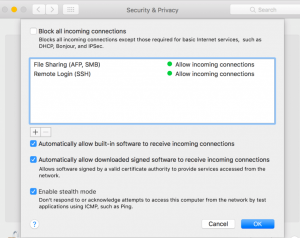


- #Kitematic configure network how to
- #Kitematic configure network for mac
- #Kitematic configure network code
- #Kitematic configure network password
- #Kitematic configure network mac
You can still access the Preferences and the Troubleshoot menu from the Dashboard when you’ve paused Docker Desktop. You can resume Docker Desktop when you want by clicking the Resume option.įrom the Docker menu, select > Pause to pause Docker Desktop.ĭocker Desktop now displays the paused status on the Docker menu and on the Containers / Apps, Images, Volumes, and Dev Environment screens on the Docker Dashboard. This reduces the CPU usage and helps you retain a longer battery life on your laptop. When you pause Docker Desktop, the Linux VM running Docker Engine is paused, the current state of all your containers are saved in memory, and all processes are frozen. Starting with the Docker Desktop 4.2 release, you can pause your Docker Desktop session when you are not actively using it and save CPU resources on your machine.
#Kitematic configure network code
Enter the six-digit code from your phone and then click Verify.Īfter you have successfully authenticated, you can access your organizations and repositories directly from the Docker Desktop menu.
#Kitematic configure network password
Go to the Docker Desktop menu and then select Sign in / Create Docker ID.Įnter your Docker ID and password and click Sign in.Īfter you have successfully signed in, Docker Desktop prompts you to enter the authentication code. For instructions, see Enable two-factor authentication for Docker Hub.Īfter you have enabled two-factor authentication: You must enable two-factor authentication in Docker Hub before signing into your Docker Hub account through Docker Desktop. Two-factor authentication provides an extra layer of security when accessing your Docker Hub account. Once logged in, you can access your Docker Hub repositories and organizations directly from the Docker Desktop menu.įor more information, refer to the following Docker Hub topics:ĭocker Desktop enables you to sign into Docker Hub using two-factor authentication. Select Sign in /Create Docker ID from the Docker Desktop menu to access your Docker Hub account. $ ln -shi /Applications/Docker.app/Contents/Resources/etc/docker-compose.fish-completion ~/.config/fish/completions/docker-compose.fish $ ln -shi /Applications/Docker.app/Contents/Resources/etc/docker.fish-completion ~/.config/fish/completions/docker.fish If you have this directory structure, you do not need to manually add the CA Messages on the command line, as well as on the registry. Like docker run that attempt to pull from the registry produce error Under insecure registries, and does not send client certificates. Docker Desktop ignores certificates listed The registry cannot be listed as an insecure registry (see DockerĮngine. Or to the ~/.docker/certs.d directory in order for the changes to take You need to restart Docker Desktop after making any changes to the keychain
#Kitematic configure network mac
When the Docker Desktop application starts, it copies the ~/.docker/certs.dįolder on your Mac to the /etc/docker/certs.d directory on Moby (the Docker Self-signed Registry Certs to Docker & Docker Desktop for
#Kitematic configure network how to
Keychain or to the ~/.docker/certs.d directory in order for the changes toįor a complete explanation of how to do this, see the blog post Adding Note: You need to restart Docker Desktop after making any changes to the $ security add-trusted-cert -d -r trustRoot -k ~/Library/Keychains/login.keychain ca.crt To manually add a custom, self-signed certificate, start by adding theĬertificate to the macOS keychain, which is picked up by Docker Desktop. Trusted by the user on the host, it is trusted by Docker Desktop. Docker Desktop creates aĬertificate bundle of all user-trusted CAs based on the Mac Keychain, andĪppends it to Moby trusted certificates. Add custom CA certificates (server side)Īll trusted CAs (root or intermediate) are supported. Server certificates) and client certificates (used to authenticate to You can add trusted Certificate Authorities (CAs) (used to verify registry
#Kitematic configure network for mac
It's added to /etc/my_init so it's run on every start.The Docker Desktop for Mac user manual provides information on how to Add TLS certificates and other useful topics.įor information about Docker Desktop download, system requirements, and installation instructions, see Install Docker Desktop. I called it firstrun.sh, but you can call it whatever you want. It checks if /config/addons exists and if not moves the settings from /usr/share/openhab to /config. So what I did was to make a new script that runs every time the container starts. Not sure why, but I guess there is an explanation for this also. You can read about it in this article Įven moving the volume mapping after the install script was run didn't make any difference. But because you used the volume mapping before the install script any changes made to /config doesn't stick. Volume mapping is tricky when used in a Dockerfile, and I didn't know this myself either. I decided to take a look at what was happening and found the problem.


 0 kommentar(er)
0 kommentar(er)
